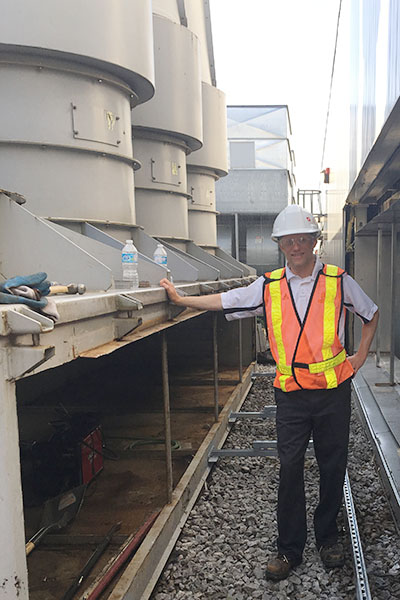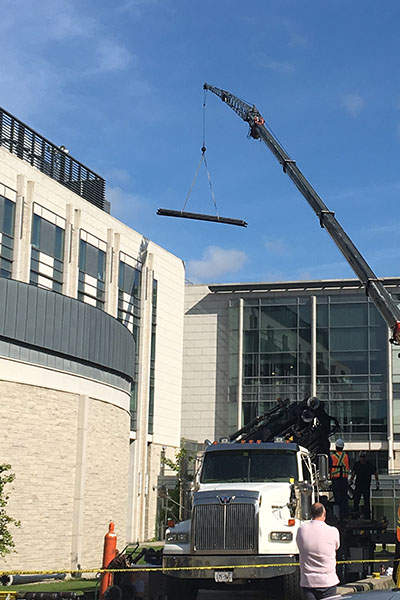Creating a smaller carbon footprint
October 6, 2017
Share
As part of the CAPit project, the single largest greenhouse gas (GHG) reduction project in the history of Queen’s University will soon drastically reduce the carbon footprint of Chernoff Hall.

Throughout the month of August, new heat recovery glycol coils were installed atop the building that is home to the Department of Chemistry.
The $900,000 project, which is part of a larger comprehensive energy conservation program (ESCo) with Honeywell, will help reduce the university’s energy consumption and costs, and mitigate campus greenhouse gas emissions. The project is a massive undertaking, requiring heavy cranes to lift the equipment so it could be installed.
The payoff is expected to be quick, however, with an estimated energy savings of close to $100,000 per year. The reason for the big savings is that chemistry labs – there are 170 fume hoods in Chernoff Hall – require the air to be replaced every 15 minutes in order to prevent any buildup of fumes from projects and experiments, as well as maintaining temperature levels that are vital for work with solvents. In contrast, a typical building on campus will see its air replaced every one or two hours.
The project was developed by the Energy Management team in Physical Pant Services (PPS) in conjunction with project partner Honeywell. The project is part of the larger CAPit program, which is a strategic investment by Queen’s to reduce energy costs and GHGs .
“This project is one we have had on our radar for a few years and although the construction takes just a few months, we have spent over a year planning the design. It’s a great project but now it’s time to start planning for our next one,” says Nathan Splinter, Energy Manager for PPS.
The nature of lab buildings requires all the air entering to only be used for a short time and cannot be recirculated. This near-constant heating and air exchange requires a lot of machinery and the top two floors of Chernoff Hall are dedicated to these tasks. As a result, the carbon footprint for the 15-year-old building was substantial.
The project is important for the Department of Chemistry as well as the university on a number of levels, says Hans-Peter Loock, Head, Department of Chemistry.
“It is a tremendous savings. If you are business-minded that is the important thing to you but for us chemists the reduction of the carbon footprint is important as well because we actually all are environmentalists at heart. Many of us go into chemistry because we want to do some good for society either as an environmental chemist or through green chemistry or monitoring of the environment,” he says. “No one knows carbon footprints better than chemists. We do care about that.”

One innovation being utilized in the project is that exhaust air will be used to help pre-heat incoming air. By recycling the heat already created, the amount of energy being used overall will be reduced.
“The energy we are saving corresponds to about 100 residences, which corresponds to approximately 634 tons of carbon dioxide,” Dr. Loock says.
However, a project of this magnitude also came at a cost for those who do their work and research in Chernoff Hall. Over the four weeks, work capacity was reduced, including a pair of two-day shutdowns as equipment was installed.
An inconvenience for sure, Dr. Loock says, but one that all involved were willing to make.
“Ventilation is a matter of safety for us. To most people it is a convenience to have fresh air at a stable temperature but for us it is important because if we don’t exchange our air, fumes fill the lab, temperatures rise and it is no longer a safe place to work,” he explains.
Throughout the shutdown process Physical Plant Services and Honeywell monitored every lab for temperature, carbon monoxide and hydrocarbons to ensure safety.
The multi-year ESCo project involves more than 170 individual energy conservation measures in 66 campus building, such as installation of low-flow fixtures to reduce water usage, upgraded lighting and building climate controls to reduce energy consumption, as well as recovery systems and improvements to building envelopes. The program is aiming for an annual carbon reduction of about 2,800 tons – the equivalent of taking 944 mid-sized cars off the road – and an overall reduction of 26 per cent since 2008, when Queen’s started its GHG inventory
“It is important for Queen’s University to be taking action on Climate Change and utilizing technology and resources to find and implement financial and environmentally sustainable solutions,” says Donna Janiec, Vice-Principal (Finance and Administration). “The CAPit project has been successful in balancing these priorities and the project at Chernoff Hall is a great example of the projects which save money and reduce our carbon footprint."